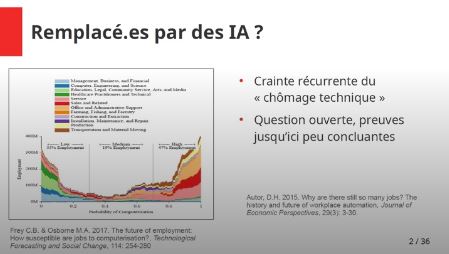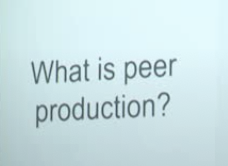Notice
Artificial Intelligence and Copyright: The Way Forward
- document 1 document 2 document 3
- niveau 1 niveau 2 niveau 3
Descriptif
We are living through a revolution in the production of artistic, literary and musical works that have been generated in some shape or form by artificial intelligence (AI). Take the following paragraph:
“One can have many opinions and still have strong values and morals. The phrase « all opinions are equal » is only the correct one when we understand that no opinion, no matter how stupid or contrary to reality, will ever be given any special place in our discussion. No one has the right to censor you because of your opinions…”
These is a readable text, but it doesn’t make much sense, you may expect it to come from a non-native speaker, or perhaps to be the ramblings of a bored Internet users. However, the text was generated by a language model called GPT-2, developed by Open AI.1 This is just one of the many tools that are being developed that can produce uncanny works that mimic human creativity. Take two other Open AI tools, Musenet and Jukebox. Musenet can produce musical compositions for ten instruments having been trained in classical and popular music; while Jukebox can produce music, lyrics and singing in the style of several artists such as Elvis Presley and Katy Perry.
Other AI-generated works have been widely reported in the press in recent years. For example, the AI painting called Edmond de Belamy made the news when it was sold in an auction for $432,500 USD. The painting was made by the French art collective Obvious using a machine learning algorithm designed specifically to generate images, known as a Generative Adversarial Network (GAN). The artists fed the AI over 15,000 portraits from various epochs, and produced a set of portraits of the fictional Belamy family.
There has been considerable discussion in recent years with regards to the copyright implications of the above increase in the creative capacity of artificial intelligence, and there is no consensus on the legal protection given (or not) to AI works. This presentation will discuss some of the questions, but most importantly will try to look beyond the hype to ask real questions of the viability and reach of AI creative tools, and whether we need to make changes to the law.
Intervention / Responsable scientifique
Dans la même collection
-
Qui travaille derrière l’intelligence artificielle ?Enjeux éthiques et sociétaux d’une nouvelle for…
TubaroPaolaPar Paola Tubaro Qui travaille derrière l’intelligence artificielle ? Enjeux éthiques et sociétaux d’une nouvelle forme de production La présentation proposée porte le regard sur le « back-office »
-
Recommandation algorithmique et diversité de l’information : comment analyser l’impact des algorith…
TarissanFabienQue ce soit des problématiques de classement de l’information (moteurs de recherche) ou celles de la recommandation de contenus (via les réseaux sociaux notamment), les algorithmes sont au cœur des
-
Où en sont les utopies productives ? Plateformes, makers et fabrication distribuée
Berrebi-HoffmannIsabelleLa sociologie considère depuis longtemps les formes de la division du travail comme centrales dans la constitution de nos sociétés et de ses institutions. Depuis un peu plus d’une dizaine d’années,
-
Swimming up the waterfall: Researching the permanence and ephemerality of 4chan/pol/
BachDanielSwimming up the waterfall: Researching the permanence and ephemerality of 4chan/pol/ From Anonymous to QAnon and LOLcats to Pepe the Frog, the infamous forum 4chan has continued to act as a fertile
-
Les Peer Production Studies : un champ de recherche à construire ?
O'NeilMathieuAu cours des années 1970, un champ de recherche interdisciplinaire s’érigea contre les dominations de classe, de genre, et de race, dans la société et dans l’université : les Cultural Studies. Un
-
Les Peer Production Studies : un champ de recherche à construire ? discussion
O'NeilMathieuAu cours des années 1970, un champ de recherche interdisciplinaire s’érigea contre les dominations de classe, de genre, et de race, dans la société et dans l’université : les Cultural Studies. Un
-
The Internet of (Artificially Intelligent) Bodies Part 2
MatwyshynAndreaANDREA MATWYSHYN The Internet of (Artificially Intelligent) Bodies This talk introduces the ongoing progression of the Internet of Things (IoT) into the Internet of Bodies (IoB)—a network of
-
The Internet of (Artificially Intelligent) Bodies Part 1
MatwyshynAndreaANDREA MATWYSHYN The Internet of (Artificially Intelligent) Bodies This talk introduces the ongoing progression of the Internet of Things (IoT) into the Internet of Bodies (IoB)—a network of
-
Mapping the Manosphere: analysing the manosphere on Reddit
CoplandSimonRecent years have seen an emergence of a diverse range of online male communities, primarily through sites such as 4chan and Reddit. Theorists, as well as the users of these spaces themselves,
-
Des utopies du net aux start-ups administratives : la place des acteurs publics dans la révolution …
BellonAnneLe développement de l'internet a souvent été étudié comme un phénomène déstabilisant les modes d'organisation bureaucratique et d'intervention des États : l'infrastructure décentrée du net permet en
-
Discussion - The Promise and Perils of Public-Private Partnerships around Data for Social Good
VerhulstStefaan G.“Data Collaborative” refers to an emergent form of public-private partnership in which actors from different sectors exchange and analyze data (and/or provide data science insights and expertise) to
-
The Promise and Perils of Public-Private Partnerships around Data for Social Good
VerhulstStefaan G.“Data Collaborative” refers to an emergent form of public-private partnership in which actors from different sectors exchange and analyze data (and/or provide data science insights and expertise) to













